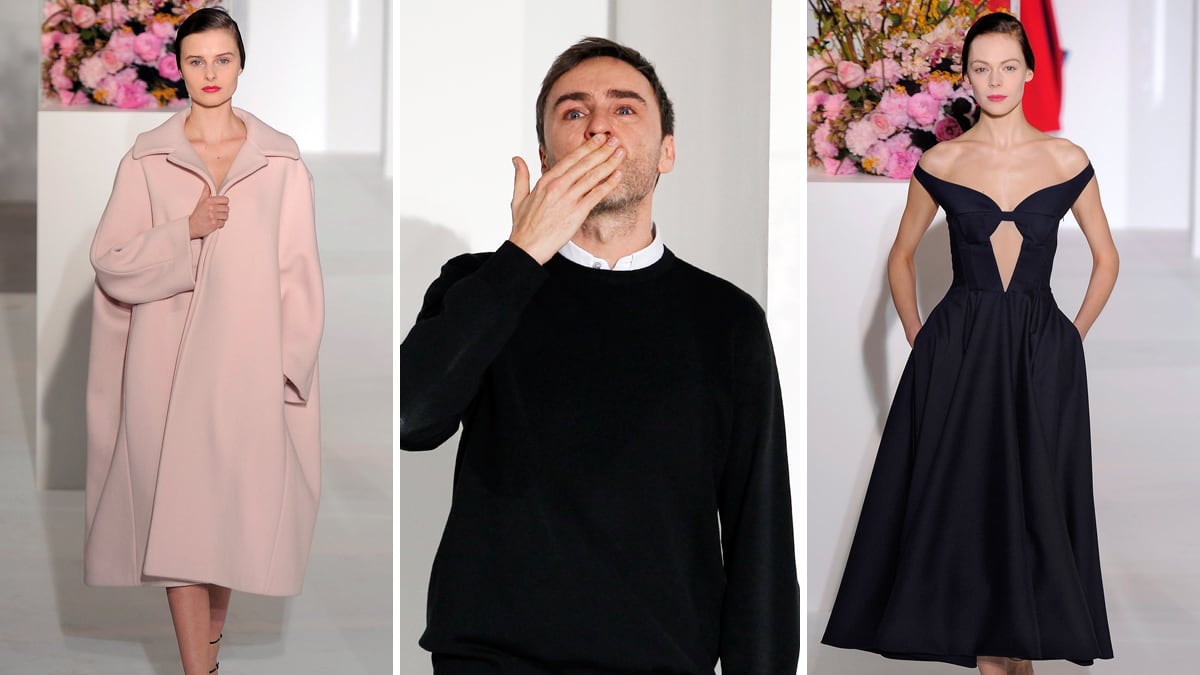
It’s not often that editors, stylists, and photographers give a fashion designer a standing ovation at the end of a runway show. But when Raf Simons presented his final collection for Jil Sander on Saturday afternoon, guests not only stood in praise of his womenswear, they cheered as he modestly took a bow and then retreated backstage.
But that did not satisfy the crowd. The applause didn’t die; it only grew louder and the cheering more emphatic. The audience was not yet done showering Simons with adulation. When the designer returned to the stage for an encore, his face was flush with the emotion of the moment. The Raf Simons era had ended at Jil Sander.
His last hurrah, for fall 2012, was a beautiful evocation of the spare silhouettes and enchanting color palette that have come to define the brand. On a white stage, six pedestals supported display boxes filled with an array of flowers in full bloom. As the models walked out with a steady, subtle grace, they revealed oversize double-face coats clutched closed at the neck. Pale pink reversed to ivory; blush was backed by milk chocolate brown. What was hiding underneath this cozy shelter? Slender dresses were constructed in a collage of delicate knits and woolens in shades of pale rose, hot pink, and pressed powder beige. Other dresses were more structured—their bodices seamed and stitched to follow the contours of the body but their skirts loose-fitting and playfully off-kilter and asymmetrical.
Soon the delicate color story deepened to include bright rose coats with bracelet-length sleeves. One dress juxtaposed the bright, girlish hue with white. Then the collection moved on to black coats and cinched-waist dresses in an assortment of textures from glossy to matte so that the eye never grew dull.
The collection was focused, which is to say, there was not a great deal of variety on this runway. There was not a little something for everyone. Instead, it was a collection with a clear and confident point-of-view. It mixed the intellectual challenges of unusual fabrics, mixed textures and strong proportions with the emotional jolt brought on by colors both sweet and powerful.
The collection was an exclamation point on a fine career at this label, one that began when Simons arrived at Jil Sander in 2005. He leaves behind a company that has grown extraordinarily influential in setting the direction of fashion each season. His successor, of course, is the woman who founded the company in 1968: its namesake, Jil Sander.
She returns to a brand that has grown up and flourished without her. And with Simons’s final collection, which was both exquisitely beautiful and wholly wearable, one is left to wonder not whether Sander can live up to her own legacy, but whether she can live up to his.
If the Jil Sander collection was an expression of fall fashion as morning light, Bottega Veneta offered twilight elegance. It was a perfectly played symphony of silhouette, color, and texture—a bravura performance, an aesthetic rarity.
Designer Tomas Maier presented a collection that was rich, sophisticated, and covetous. It offered proof that a fashion label does not need a flashy designer firing off pyrotechnics of technology and sex appeal in order to dazzle the eye. Maier stayed true to a vision he defined during his first days at Bottega Veneta when he created a simple woven handbag that expressed the glory of materials, history, and personal savoir-faire.
As models strode out in pairs—walking on parallel white lacquer runways—there wasn't a single misfire, not a single disruptive "oops" moment when taste or skill skipped a beat. The collection flowed seamlessly, beginning with deeply colored coat dresses with jagged scars cutting across the side seams. This was polished daywear: professional, refined, and hinting at a creative personality that belies sober briefcases and dueling Blackberries. Pencil skirts were decorated at the waist with demi-peplums—little clouds of crepe and chiffon that softened what could have been a severe silhouette.
The jewelry—rock crystals inset in silver—was bold but not ostentatious thanks to its antique finish and heirloom quality. The shoes and boots, with their modest heels, gave the models a look of agility and ease.
The evening gowns served as Maier’s final word on discretion, sophistication, and beauty. The velvet dresses in black, burgundy, and abstract prints moved around the body—caressing it and alluding to every curve. Beautiful seams snaked along the torso. Tiny hooks and eyes rose straight up the back on a corset-style bodice. There was no heaving cleavage, no dangerously high slits, no bared midriffs. Maier doesn’t just want to show off the female form, he wants to celebrate its mysteries.






